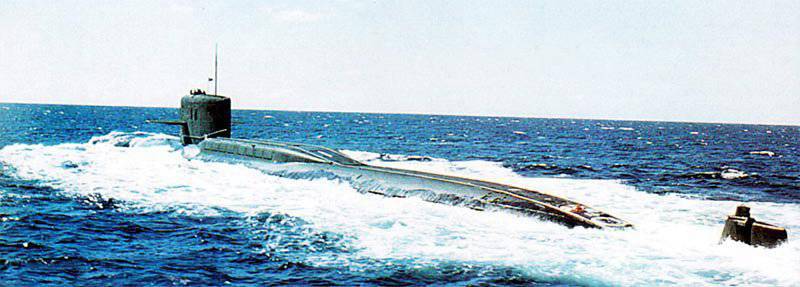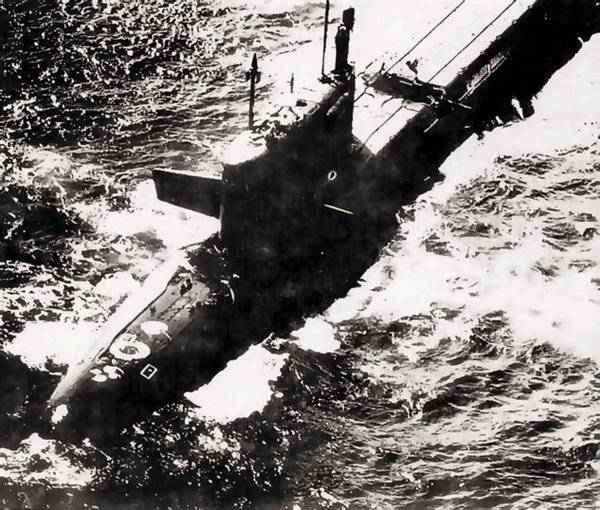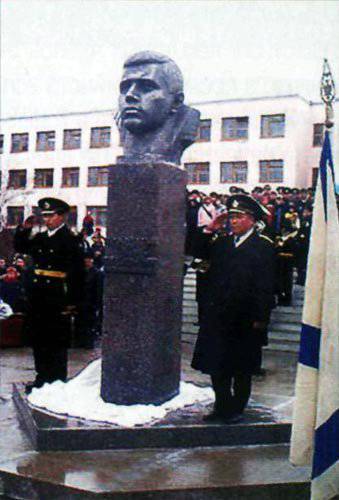America owes Russian sailor

THIRTEENTH BATTLE
In September 1986, a Soviet strategic missile submarine K-219 of project 667AU (these Soviet submarines were classified as “Yankees”) went on combat alert from the Barents Sea to the Atlantic, performing its 13th combat service. Passing through the northern seas, the cruiser went to the ocean. But before, he had to overcome the system of sonar detection tools. NATO allies did not stint, creating a global system of anti-submarine borders. Thousands of sensors located in the path of our submarines deliver information to the SOSUS center in Norfolk, equipped with the latest technology, from where this data goes to the anti-submarine command aviation and the American Navy. By that time, the SOSUS center and every modern American nuclear submarine (ALL) had the noise characteristics of almost all of our ships.
One of the most reliable methods known to domestic submariners is to disguise under the noises of a civilian vessel. The commander of K-219, captain of the 2 rank, Igor Britanov, waited for two days at the designated point of his “guide”. It was not an accidental seiner, the vessel was following a strictly defined course according to the instructions previously approved by the Navy General Headquarters. SSBN "clung" to him and, disguised by noise, slipped into the combat patrol area. Of course, Britanov did not hope to knock Americans off the track so easily. Too convenient for the submarine vessel, so that he did not pay attention. Naturally, the Americans were alert. But everything takes time to separate the noises of the surface and underwater ship, determine its class, try to predict the course ... The commander of the Soviet boat had time to maneuver and delayed for a few days, and maybe weeks, an unwelcome meeting with the “hunter” - the “Augusta” "Type" Los Angeles ", which has already scoured squares in search of K-219. The crew managed to break away from the persistent American.
Here is the square patrol. Now you can go with a minimum speed, remove mechanisms that do not affect the course and control of the boat, in order to minimize the noise of the cars. Hydroacoustics listen to the sea all the time, but they do not see anything suspicious. Augusta is also extremely cautious. Here are the possibilities of the hydroacoustic complex, it is much wider, it is the newest American torpedo boat, which is not even a year old. Our submarine, in the year of death, turned fifteen.
About 5 o'clock in the morning 3 October 1986, after another podsplyutiya on the session, using intelligence from the headquarters, and even more trusting their instincts, Britans decides to get rid of the American "tail." He gives the order to conduct a maneuver, known to all the submariners of the time. “Crazy Ivan” is what the Americans called this tactical device: the submarine increases speed, turns sharply backwards and drops the course. This forces the pursuer to also increase speed in order to keep in the stern of the target. Naturally, the noise of the boat-pursuer increases dramatically, and there is a chance for its detection. However, the maneuver is fraught with the danger of a collision; having conducted it, the pursued submarine literally enters a frontal attack. But this is a chance, maybe the only one, to identify the enemy.
ACCIDENT IN MISSILE MINE
At the time of the maneuver, the body of one of the X-NUMX ballistic missiles K-16 burst. Russian submariners are still arguing about what could have caused this. According to one version, it all happened because of a malfunction of the rocket apparatus, the mine was emergency even before the boat left the base. But the commander of the missile warhead captain 219-rank Alexander Petrachkov did not report this to the commander, relying on his own forces. According to this version, water flowed into the emergency rocket mine during the entire march, and it was pumped out constantly. The commander was presented with the presence of water in the mine as the appearance of condensate.

According to another version, which, incidentally, is taken for the faithful admiral fleet V. Chernavin, the appearance of water in a rocket mine is a consequence of a collision with an American boat. According to some crew members, a few minutes before the explosion, they felt two jolts, and after an emergency ascent on the black body of the submarine, two furrows were visible.
Be that as it may, the thin shell of a ballistic missile did not withstand the onslaught, or rather the pressure of water. According to experts who investigated the causes of the explosion, an oxidant tank burst in an amputated P-27 rocket, a rocket fuel component was leaked. From that moment on, nitric acid began to devour everything it could get to. And the first thing she got to the rocket itself. The mine’s armature lost its tightness, and a highly toxic oxidant heptyl began to flow into the compartment, which caused an intense fire. Within a short time, the compartment was heavily gassed, and the level of contamination by oxidant vapors exceeded the maximum permissible concentrations thousands of times.
The crew began the struggle for survivability. But no one really knew how to deal with this misfortune. The instructions drawn up for the most unforeseen situations did not provide for such an accident. It is extremely difficult to fight with the heptal oxidizer. By virtue of its chemical activity, it is able to instantly pierce a hole in a steel pipeline, when in contact with easily combustible materials, it ignites them. A conventional foam extinguisher or water cannot cope with it, it supports any kind of burning without air. Oxidizing fumes are extremely dangerous: inhalation of tenths of a gram is fatal.
The rocket oxidizer, and with it the fire, spread to the adjacent compartments. To top it off, the ship lost power supply on one side — emergency protection of one reactor worked.
Immediately after that, a strong explosion thundered in an emergency mine. The top cover was torn off and, together with the warhead, the missiles were thrown out of the boat, and cracks appeared in the places of welded joints of the container and the strong submarine hull. At that moment, the teams of Britanov and the captain of 2 rank Igor Petrovich Krasilnikov, commander of the electromechanical warhead (CU-5), sounded: “Float up! Blow out the middle! ”But the boat continued to fall. Depth 70 meters, 90 ... Too short. The boat continues to dive, and only having reached the depth of 117 meters, she first freezes and then begins to ascend.
Two minutes after the explosion, which seemed like an eternity to the crew, the boat floated to the surface. A fire was burning in the missile compartment, reactors next to it ... Emergency compartments are abandoned, submariners are transported to a safe place, and the head of the medical service, Igor Kochergin, is doing everything possible and impossible to save his comrades. Emergency parties have to work in very difficult conditions: in hot compartments, in the light of emergency lamps, with constant rolling. In this situation, remarkable comforts, restraint and skill were demonstrated by all: the captain, the commander of the electromechanical warhead, and the entire crew of the submarine.
FROM A NUCLEAR EXPLOSION WORLD SPAS SERGEY PREMININ

Compressed bulkhead doors of the missile compartments divided the crew into two parts - prisoners of the bow and stern compartments. After a grueling fifteen-hour struggle for survivability, a report was received from the reactor compartment: it was not possible to recover and energize the drives of the compensation grids of the absorbers, which hung in an intermediate position after de-energizing and dropping the emergency protection of one of the nuclear reactors. There was a real threat of a second Chernobyl, just off the coast of the United States. The reactor had to be shut down immediately, but the remote control failed. The only way to prevent a possible catastrophe is to manually shut off the reactor. To do this, you need to enter the gas-filled 7 compartment, penetrate the hardware enclosure and manually lower all compensating grids to the lower stops with a special key. The emergency party tried to break through to the reactor compartment six times, but the emergency services failed to lower the compensation grids.
And then Senior Lieutenant Nikolai Belikov and bilge sailor Sergey Preminin went to the compartment. Dressed in protective suits, they entered the hardware enclosure. Nikolai found a safe with a key for manual lowering of the compensating grids. I had to work with a sledgehammer to bring down the constipation. Then Belikov set the key and tried to make at least a few turns. Each movement was worth incredible efforts. And yet, together, changing each other, they manually lowered (and this is the 240 revolutions key) three of the four grids. They were taken out of the compartment half-dead. Belikov did not regain consciousness. It was necessary to omit the last, fourth grid. Now only one member of the crew could do it - sailor Preminin. He knew that he was in mortal danger, but took this step.

Preminin drowned out the reactor. However, I could not return back. "I can not open the bulkhead, does not go," - said Sergey. The bulkhead tightened with the increased pressure, and the sailor didn’t even have enough strength to get up from his knees, turn the valve and equalize the pressure between the seventh and the eighth. Senior Midshipman Vasily Yezhov and two sailors stormed the door jammed in vain, although they understood that all the imaginable terms of the work of Sergei’s isolation equipment had expired. With tears in their eyes, the submariners listened to Sergey’s knocks from the reactor compartment. The sailor fulfilled his duty to the end, remaining close to the defeated reactor. Sergei Anatolyevich Preminin was twenty-one.
... By the decree of the Presidium of the Supreme Soviet of the USSR, sailor Sergei Preminin was awarded the Order of the Red Star. And later 10 years by the Decree of the President of the Russian Federation No. 844 from 7 of August 1997, he was awarded the title Hero of the Russian Federation.
Years have passed, but the memory of the Hero of Russia a submariner sailor Sergey Preminin is alive. In the city of Gadzhiyevo, from where the K-219 submarine left on its last combat duty, a monument to Sergei Preminin was installed, the quay bears his name, and the school is named after him.
THE LAST LEAVES COMMANDER
The ship was doomed. The fire continued on it, the outboard water slowly flowed, and the acid, at a millimeter-hour rate, corroded the robust cruiser hull. In a boat equipped with sixteen ballistic missiles, a fire is raging. Next - two nuclear reactors. In the first compartment - torpedoes. We needed urgent, qualified, well-equipped outside help. For obvious reasons, the Soviet seamen refused the help of the Americans, moreover, the Soviet ships were already hurrying to the scene of the accident. However, the attempt to tow an emergency submarine was not crowned with success.
In 11 hours 03 minutes nuclear icebreaker snooted on the horizontal rudders. The last commander leaves the perishing ship under the law of the sea. Three minutes after he left the cruiser, the K-219 began to sink. In mournful silence, the sailors watched the elements absorb their native ship. Our civilian ships, which had picked up submariners by this time, tried to get out of the cruiser’s death place as quickly as possible.

LIGHT MEMORY KILLING
As a result of the tragedy, four members of the K-219 crew were killed.
1. Captain 3-rank Alexander Petrachkov - died in the emergency compartment.
2. Sailor Nikolai Smaglyuk - died at the very first moment after the explosion, was in the cabin, next to the emergency compartment.
3. Sailor Igor Kharchenko - died at the very first moment after the explosion, was in the cabin, next to the emergency compartment.
4. Sailor Sergey Preminin - died at a combat position, at the cost of his life, drowning the reactor.
Light memory to them!
Information